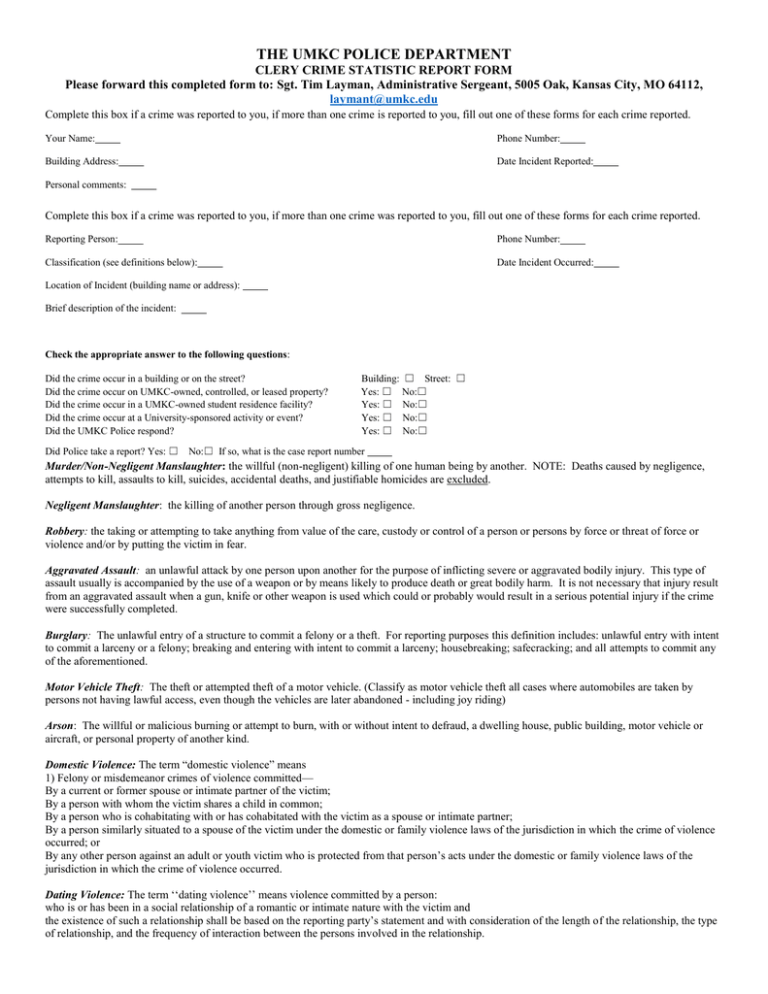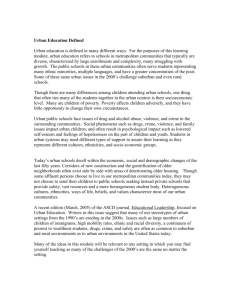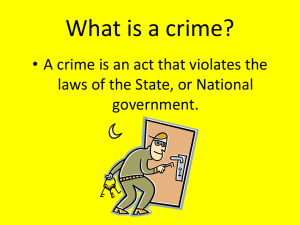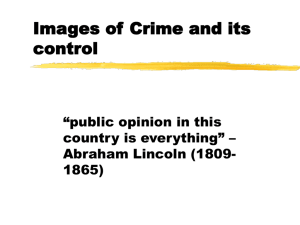
THE UMKC POLICE DEPARTMENT
CLERY CRIME STATISTIC REPORT FORM
Please forward this completed form to: Sgt. Tim Layman, Administrative Sergeant, 5005 Oak, Kansas City, MO 64112,
laymant@umkc.edu
Complete this box if a crime was reported to you, if more than one crime is reported to you, fill out one of these forms for each crime reported.
Your Name:
Phone Number:
Building Address:
Date Incident Reported:
Personal comments:
Complete this box if a crime was reported to you, if more than one crime was reported to you, fill out one of these forms for each crime reported.
Reporting Person:
Phone Number:
Classification (see definitions below):
Date Incident Occurred:
Location of Incident (building name or address):
Brief description of the incident:
Check the appropriate answer to the following questions:
Did the crime occur in a building or on the street?
Did the crime occur on UMKC-owned, controlled, or leased property?
Did the crime occur in a UMKC-owned student residence facility?
Did the crime occur at a University-sponsored activity or event?
Did the UMKC Police respond?
Did Police take a report? Yes: ☐
Building: ☐ Street: ☐
Yes: ☐ No:☐
Yes: ☐ No:☐
Yes: ☐ No:☐
Yes: ☐ No:☐
No:☐ If so, what is the case report number
Murder/Non-Negligent Manslaughter: the willful (non-negligent) killing of one human being by another. NOTE: Deaths caused by negligence,
attempts to kill, assaults to kill, suicides, accidental deaths, and justifiable homicides are excluded.
Negligent Manslaughter: the killing of another person through gross negligence.
Robbery: the taking or attempting to take anything from value of the care, custody or control of a person or persons by force or threat of force or
violence and/or by putting the victim in fear.
Aggravated Assault: an unlawful attack by one person upon another for the purpose of inflicting severe or aggravated bodily injury. This type of
assault usually is accompanied by the use of a weapon or by means likely to produce death or great bodily harm. It is not necessary that injury result
from an aggravated assault when a gun, knife or other weapon is used which could or probably would result in a serious potential injury if the crime
were successfully completed.
Burglary: The unlawful entry of a structure to commit a felony or a theft. For reporting purposes this definition includes: unlawful entry with intent
to commit a larceny or a felony; breaking and entering with intent to commit a larceny; housebreaking; safecracking; and all attempts to commit any
of the aforementioned.
Motor Vehicle Theft: The theft or attempted theft of a motor vehicle. (Classify as motor vehicle theft all cases where automobiles are taken by
persons not having lawful access, even though the vehicles are later abandoned - including joy riding)
Arson: The willful or malicious burning or attempt to burn, with or without intent to defraud, a dwelling house, public building, motor vehicle or
aircraft, or personal property of another kind.
Domestic Violence: The term “domestic violence” means
1) Felony or misdemeanor crimes of violence committed—
By a current or former spouse or intimate partner of the victim;
By a person with whom the victim shares a child in common;
By a person who is cohabitating with or has cohabitated with the victim as a spouse or intimate partner;
By a person similarly situated to a spouse of the victim under the domestic or family violence laws of the jurisdiction in which the crime of violence
occurred; or
By any other person against an adult or youth victim who is protected from that person’s acts under the domestic or family violence laws of the
jurisdiction in which the crime of violence occurred.
Dating Violence: The term ‘‘dating violence’’ means violence committed by a person:
who is or has been in a social relationship of a romantic or intimate nature with the victim and
the existence of such a relationship shall be based on the reporting party’s statement and with consideration of the length of the relationship, the type
of relationship, and the frequency of interaction between the persons involved in the relationship.
Stalking: The term “stalking” means engaging in a course of conduct directed at a specific person that would cause a reasonable person to—
Fear for the person’s safety or the safety of others; or
Suffer substantial emotional distress.
Weapon Law Violations: The violation of laws or ordinances dealing with weapon offenses, regulatory in nature, such as: manufacture, sale, or
possession of deadly weapons; carrying deadly weapons, concealed or openly; furnishing deadly weapons to minors; aliens possessing deadly
weapons; all attempts to commit any of the aforementioned.
Drug Abuse Violations: Violations of state and local laws relating to the unlawful possession, sale, use, growing, manufacturing, and making of
narcotic drugs. The relevant substances include: opium or cocaine and their derivatives (morphine, heroin, codeine); marijuana; synthetic narcotics
(Demerol, methadones); and dangerous non-narcotic drugs (barbiturates, Benzedrine).
Liquor Law Violations: The violation of laws or ordinance prohibiting: the manufacture, sale, transporting, furnishing, possessing of intoxicating
liquor; maintaining unlawful drinking places; bootlegging; operating a still; furnishing liquor to minor or intemperate person; using a vehicle for
illegal transportation of liquor; drinking on a train or public conveyance; all attempts to commit any of the aforementioned. (Drunkenness and
driving under the influence are not included in this definition.)
NOTE: The above listed crime definitions from the Uniform Crime Reporting Handbook
Sexual Assault
Rape: The penetration, no matter how slight, of the vagina or anus with any body part or object, or oral penetration by a sex organ of another person, without the
consent of the victim.
Forcible Fondling: The touching of the private parts of another person for the purposes of sexual gratification, without the consent of the victim, including instances
where the victim is incapable of giving consent because of his/her age or because of his/her temporary or permanent mental incapacity.
Incest: Nonforcible sexual intercourse between persons who are related to each other within the degrees wherein marriage is prohibited by law.
Statutory Rape: Nonforcible sexual intercourse with a person who is under the statutory age of consent.
NOTE: The above listed Sex Offenses Definitions From the National Incident-Based Reporting System Edition of the Uniform Crime Reporting Program
HATE CRIMES
UMKC is also required to report statistics for hate (bias) related crimes by the type of bias as defined below for the following classifications: murder/non-negligent
manslaughter, negligent manslaughter, sex offenses (forcible and non-forcible), robbery, aggravated assault, burglary, motor vehicle theft, arson (see definitions above)
and larceny, vandalism, intimidation, and simple assault (see definitions below).
Larceny: The unlawful taking, carrying, leading, or riding away of property from the possession or constructive possession of another.
Vandalism: To willfully or maliciously destroy, injure, disfigure, or deface any public or private property, real or personal, without the consent of the owner or person
having custody or control by cutting, tearing, breaking, marking, painting, drawing, covering with filth, or any other such means as may be specified by local law.
Intimidation: To unlawfully place another person in reasonable fear of bodily harm through the use of threatening words and/or other conduct, but without displaying a
weapon or subjecting the victim to actual physical attack.
Simple Assault: An unlawful physical attack by one person upon another where neither the offender displays a weapon, nor the victim suffers obvious severe or
aggravated bodily injury involving apparent broken bones, loss of teeth, possible internal injury, severe laceration or loss of consciousness.
_________________________________________________________________________________________
If a hate crime occurs where there is an incident involving intimidation, vandalism, larceny, simple assault or other bodily injury, the law requires that the statistic be
reported as a hate crime even though there is no requirement to report the crime classification in any other area of the compliance document.
A hate or bias related crime is not a separate, distinct crime, but is the commission of a criminal offense which was motivated by the offender's bias. For example, a
subject assaults a victim, which is a crime. If the facts of the case indicate that the offender was motivated to commit the offense because of his bias against the victim's
race, sexual orientation, etc... the assault is then also classified as a hate/bias crime.
If a hate (bias) related crime was reported to you, please fill out the top section of Page 1 and then complete the following information about the type of bias
involved in the crime.
Type of Bias:
Race ☐
Religion
☐
Gender ☐
Gender Identity ☐
Ethnicity ☐
National Origin ☐
Sexual Orientation ☐
Disability ☐







